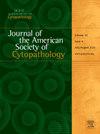The International System for Serous Fluid Cytopathology (TIS) survey in preparation for TIS 2.0
Q2 Medicine
Journal of the American Society of Cytopathology
Pub Date : 2025-03-01
DOI:10.1016/j.jasc.2024.12.001
引用次数: 0
Abstract
Introduction
The International System for Serous Fluid Cytopathology (TIS) has gained acceptance and has led to literature validating original concepts and suggesting refinements. In preparation for the second edition of TIS, editors generated a survey to solicit experience with and opinions about TIS.
Materials and methods
An online survey available from March 8 to June 15, 2024, included 56 questions, offered in 7 languages, related to the practice of serous fluid cytopathology.
Results
A total of 598 respondents accessed the survey. Information was collected regarding certification, work setting, work volume and years in practice. In the respondent group, 78% (401 of 513) were pathologists, 18% (92 of 513) cytologists of cytotechnologists, 2% (10 of 513) trainees, and 2% (10 of 513) medical scientists. A total of 23% of participants came from academia. Also, 59% of respondents were (280 of 474) from Asia, 17% Europe, 12% North America, and 10% South America. In all, 61% (287 of 474) have adopted TIS. Over 50% issue a preliminary report awaiting ancillary test results. Another 20% issue such a report depending on circumstance. The most frequent request for refinement of criteria centered around Atypia of Uncertain Significance (AUS). Only small numbers of participants provided data on diagnostic category percentage and risk of malignancy (ROM); however, those that did reported a decrease in nondiagnostic and atypical results with corresponding decreases in ROM for those categories. Variable use of cytochemical and immunocytochemical stains for resolving mesothelial proliferations was reported. Respondents indicated a desire for incorporation of recommendations on clinical management and extension of TIS into body fluid types beyond pleural, pericardial, and peritoneal.
Conclusions
This survey examines acceptance of TIS and advice for future directions.
国际浆液细胞病理学系统(TIS)调查为TIS 2.0做准备。
简介:国际浆液细胞病理学系统(TIS)已经获得认可,并导致文献验证原始概念和建议改进。在准备第二版TIS的过程中,编辑们进行了一项调查,以征求对TIS的经验和意见。材料和方法:一项在线调查于2024年3月8日至6月15日进行,包括56个问题,以7种语言提供,与浆液细胞病理学的实践有关。结果:共有598名受访者参与了调查。收集了有关认证、工作环境、工作量和实践年数的信息。在答复组中,78%(513人中有401人)是病理学家,18%(513人中有92人)是细胞技术学家中的细胞学家,2%(513人中有10人)是实习生,2%(513人中有10人)是医学家。共有23%的参与者来自学术界。此外,59%的受访者(474人中有280人)来自亚洲,17%来自欧洲,12%来自北美,10%来自南美。总共有61%(474人中的287人)采用了TIS。超过50%的医院出具初步报告,等待辅助检测结果。另有20%的人根据情况出具此类报告。对标准的最常见的要求集中在不确定意义异型性(AUS)。只有少数参与者提供了诊断类别、百分比和恶性肿瘤风险(ROM)的数据;然而,那些报告了非诊断性和非典型结果的减少,这些类别的ROM相应减少。不同的使用细胞化学和免疫细胞化学染色解决间皮细胞增殖的报道。应答者表示希望纳入关于临床管理的建议,并将TIS扩展到胸膜、心包和腹膜以外的体液类型。结论:本调查探讨了对TIS的接受程度以及对未来发展方向的建议。
本文章由计算机程序翻译,如有差异,请以英文原文为准。
求助全文
约1分钟内获得全文
求助全文
来源期刊

Journal of the American Society of Cytopathology
Medicine-Pathology and Forensic Medicine
CiteScore
4.30
自引率
0.00%
发文量
226
审稿时长
40 days
 求助内容:
求助内容: 应助结果提醒方式:
应助结果提醒方式:


